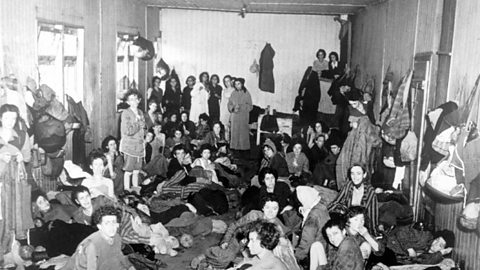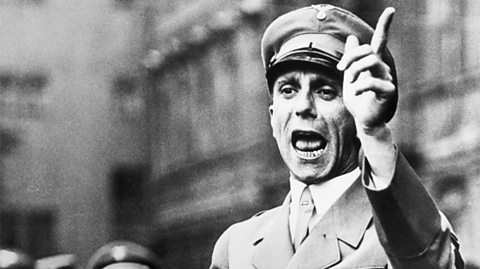nazi policestate
The nature of the Nazi Government
The Nazi Government of the 1930s developed along the lines of the ideology that Hitler described in his book, Mein Kampf.
The Führer Principle - there must be a single leader of a single party, holding complete power.
Racism - Germans were the 'Master Race' as they were descended from the Aryans and all other races were inferior. Jewish people and Slavs were regarded as subhuman. All inferior races had to be removed or made slaves of the Master Race.
Lebensraum (living space) - the territorial expansion of Germany was required in order to allow the Master Race to grow.
Autarky - meaning that Germany must be economically self-sufficient and not dependent on goods imported from abroad.
Control of Germany
Hitler introduced many policies and measures to ensure the Nazis remained in control, once he declared himself Führer in 1934 after the death of President Hindenburg.
Control through fear and oppression
The Nazis created a terror-state whereby those living in Germany were too scared to disobey Nazi laws. This was achieved through intimidation and brutality.
The Gestapo, April 1933
The Gestapo were the Nazis secret police who gathered intelligence on people living in Germany.
They had over 150,000 informants throughout the country who would report any anti-Nazi sentiment to the Gestapo.
The Gestapo and their informants did not wear uniforms and, therefore, Germans did not know when they were being spied on. This created tension and fear throughout the country.
They had powers to arrest and detain those people who were considered enemies of the state/Nazi Party. These people were often violently questioned before being released or imprisoned.
People’s courts were used to guarantee that those who the Nazis considered to be enemies were charged with treason and interred in concentration camps.
The SS
By 1934, the SS had been put in charge of protecting Germany from internal and external enemies. The SS also controlled the concentration camps where ‘undesirable people’ were imprisoned. The first concentration camp was established in Dachau in 1933.
These ‘undesirable people’ included:
political opponents
homosexuals
criminals
gypsies
Jewish people
religious figures
any out-spoken critics (including journalists and artists)

Figure caption,
Prisoners in one of the holocaust camps
Life in the concentration camps was extremely harsh. Prisoners were made to work in horrendous conditions. Stories of what prisoners experienced increased fear among the German population.
The arrest and disappearance of thousands of people, then their subsequent reappearance with tales of the concentration camps, terrified the population. This meant that there was little opposition to the Nazis in the 1930s.
Control through propaganda and censorship

Figure caption,
Joseph Goebbels
Josef Goebbels was appointed Minister of Propaganda in 1933 and aimed to brainwash people into obeying the Nazis and idolising Hitler.
Propaganda
Goebbels controlled the media and arts, making sure that Germans were fed Nazi ideology while censoring other information.
The Nuremberg Rallies, held annually from 1933, glorified war and the military.
The 1936 Berlin Olympics were intended to showcase the superior athleticism of the Master Race.
Radios were cheap to buy and would broadcast Nazi Party messages and speeches. Loudspeakers in public places blared out Nazi propaganda.
Hitler's picture was everywhere and he was portrayed as Germany's saviour. Simple slogans were used to introduce Nazi ideology to the German people:
"Free Germany from the Jews"
"Work and Bread"
"Smash Communism"
"Blood and Soil"
"One People, One Empire, One Leader"
Censorship
Any media that conveyed anti-Nazi ideas or even other ways of life, were censored. Censorship of newspapers, radio, cinema and the theatre was enforced. Only books which agreed with the Nazi point of view were allowed. All other books were banned and many were publically burned from May, 1933.
Control of the Church
Hitler believed that religion was a threat to the Nazis control over people's minds.
The Catholic Youth League was broken up, Catholic priests were arrested and religious teaching was banned.
A Protestant Reich Church, with Nazi bishops, was established.
Non-Nazi Catholic priests and Protestant pastors such as Martin Niemöller and Dietrich Bonhöffer were sent to concentration camps.
Nazi attitudes to Jewish people
The Nazis treatment of the Jewish people derived from their social and racial policies. The Nazis believed that only Germans could be citizens and that non-Germans should not have any citizenship rights.
The Nazis racial philosophy taught that some races were ‘Untermenschen’ ('subhuman'). Many scientists at this time believed that people with disabilities or social problems were genetically less human and that their genes needed to be eliminated from the human gene pool.
As a result of these beliefs, the Nazis took the following actions:
Tried to eliminate the Jewish people.
Killed 85 per cent of Germany's gypsies.
Sterilised black people.
Killed mentally ill patients.
Sterilised physically disabled people, eg deaf people, and people with hereditary diseases.
Imprisoned people they regarded as anti-social in concentration camps. These included homosexuals, prostitutes, Jehovah's Witnesses, alcoholics, pacifists, beggars, hooligans and criminals.
Persecution of Jewish people
The following shows how the Nazis treatment of the Jewish people developed during the 1930s.
1933
Jewish people were removed from public office and professions – civil servants, lawyers and teachers were sacked.
School lessons were to reflect the view that Jewish people were ‘Untermensch’.
April Boycott
On 1 April 1933, a boycott of Jewish shops and other businesses took place.
SA officers actively encouraged Germans to avoid entering Jewish places of work.
Many Jewish shops were vandalised.
1935
The Nuremberg Laws were introduced at the Nuremberg Rally on 15 September and removed many Jewish rights.
Jewish people were denied the right to be German citizens.
Marriage and relationships between Jewish people and Germans became illegal.
1938
Jewish people were banned from becoming doctors.
Jewish people had to carry identity cards which showed a ‘J’ stamp.
Jewish children were denied education and banned from schools.
Jewish men had to add ‘Israel to their name, women had to add ‘Sarah’.
Kristallnacht
On the night of the 9 November 1938 Jewish homes, businesses and synagogues were attacked throughout Germany and Austria.
Around 7,500 Jewish shops were damaged or destroyed. 400 synagogues were burned to the ground.
Almost 100 Jewish people were killed and 30,000 were sent to concentration camps.
1939
Jewish people were banned from owning businesses.
The first ghettos (segregated housing within towns, with a controlled entrance and exit) were opened in Eastern Europe to separate Jewish people from ‘ordinary’ citizens.
Star of David Emblem
On 23 November, 1939, Jewish people were ordered to wear the Star of David emblem on their clothes. This helped identify them more easily.
The Nazis persecution of the Jewish people meant that many other Germans lived in fear of the Nazis turning on them.
This severely reduced the number of people who were willing to openly oppose the Nazis.
Opposition to the Nazis
Those who spoke out against Hitler and his policies faced intimidation and threats from the Gestapo or imprisonment, and in some cases execution. Hence, there was little open opposition to Hitler.
Why was there little opposition to the Nazis?
The 'Night of the Long Knives' had eliminated almost all opposition to Hitler within the Nazi Party.
All other political parties had been banned in July 1933.
Through censorship and propaganda, the Nazis eliminated opposition in the media.
Economic opposition was eliminated as trade unions had been banned in May 1933.
Germans lived in fear of being denounced by spies, interrogated by the Gestapo and sent to concentration camps.
Many Germans genuinely believed that the Nazis were improving Germany. They saw the negative side as a ‘necessary evil’ if Germany was to be great again.
However, there were a few individuals and groups who openly opposed Hitler and his policies. The majority ended up in concentration camps, while many were killed.
Opposition from the Church
Some Catholic priests opposed Hitler. In 1937, the Pope issued a message called 'With Burning Concern' which was read in every Catholic Church. It described Hitler as “a mad prophet with repulsive arrogance”.
The Catholic Archbishop of Munster led a successful campaign to end euthanasia of mentally-disabled people.
Many Protestant pastors, led by Martin Niemöller, formed the Confessional Church in opposition to Hitler's Reich Church. Niemöller was held in a concentration camp during the period 1937-1945. Another Protestant pastor, Dietrich Bonhöffer, was linked to an assassination attempt against Hitler and was executed in 1945.
Opposition from youth
The Meuten
The Meuten were gangs of working-class teenagers and young adults.
They sympathised with socialist ideology.
They were frequently attacked by Nazis, including the Hitler Youth.
The Swing Kids
A youth movement that started in Hamburg in 1939 and spread to Berlin and other German cities.
The movement was a challenge to Hitler announcing that all German adolescents had to join a Nazi youth movement.
They challenged the Nazi image of youth by growing their hair and wearing fashionable clothes.
They also listened to swing music, which was seen by the Nazis as Black music and met at secret dance halls. This often led to clashes with the Hitler Youth and the security forces.
The White Rose
Formed by students at Munich University. They published anti-Nazi leaflets, but were discovered and executed in 1943.
The Edelweiss Pirates
They painted anti-Nazi slogans, sheltered deserters and beat up Nazi officials. In 1944, the Cologne Pirates killed the Gestapo chief.